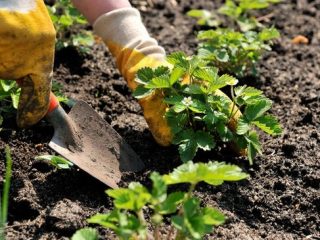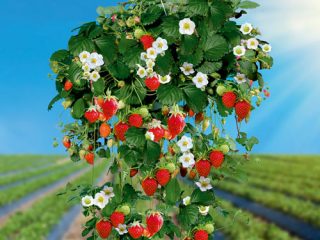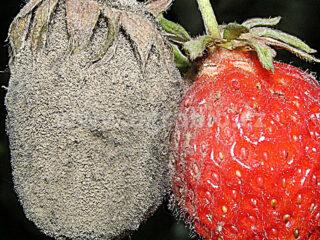Content
The Mara de Bois strawberry is a French variety. Gives very tasty berries with a bright strawberry aroma. The variety is picky about the conditions of care, poorly withstands drought, average frost resistance. Suitable for cultivation in the south, and in the regions of the middle lane - only under cover.
Breeding history
Mara de Bois is a strawberry variety bred in the 80s of the XX century by the French breeders of the Andre company on the basis of several types:
- Crown;
- Ostara;
- Gento;
- Red Gauntlet.
The variety was successfully tested and received a patent in 1991. It quickly spread in Europe and the USA. It is also known in Russia, but is not included in the register of breeding achievements.
Description of the Mara de Bois strawberry variety and characteristics
The bushes are low (on average 15–20 cm), the number of leaves is small, the growth rate is average. The apical growth is not pronounced, the plants spread well, but in general they look compact. The leaf plates are trifoliate, the color is dark green, with a bubbly surface and slightly raised edges. The foliage covers the berries well from wind and rain.
The Mara de Bois strawberry is a monoecious plant (each bush has male and female flowers). Peduncles are thin, low, covered with a small layer of pubescence. They grow at the level of foliage in large numbers. Each peduncle has 5–7 inflorescences.
Shoots are shortened, creeping, there are three types:
- Horns with rosettes of leaves (3–7 in one), give flower stalks growing from the apical buds (due to this, the yield increases).
- Whiskers are creeping branches that develop after the flowers wither. They take away a lot of moisture and nutrients, so it is better to remove them periodically.
- Peduncles are formed 30 days after the start of active growth. They emerge from flower buds. The life cycle ends with the formation of fruits (after another 30 days).
The roots are developed, whorls forming horns are noticeable at the base of the stem. In the future, each layer can take root. The root system is represented by a modified scaly stem. It feeds the plant throughout its life cycle, which lasts 3 years. After that, the root is darker and dies off. Therefore, it is better to renew the planting every 2-3 seasons.
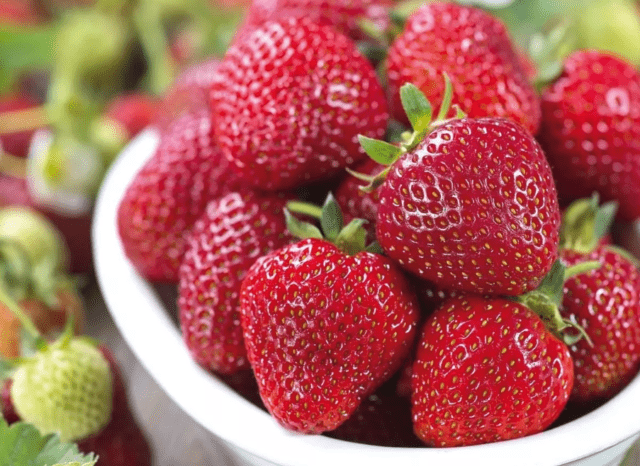
Strawberry Mara de Bois has an exquisite taste and aroma
Characteristics of fruits, taste
Berries are bright red, medium size (weight 15–20, less often up to 25 g), typical conical shape. It is noticed that in the spring and autumn, the fruits are larger than in summer. Different fruits may differ in appearance - heterogeneous. Seeds are yellow, small, shallow.
The consistency of the berries is very pleasant, tender, medium density. The taste is multifaceted, “for gourmets” (5 out of 5 points according to the tasting assessment). A sweet note is expressed, there is a pleasant sourness, a rich strawberry aroma. Small cavities are possible inside, which does not spoil the taste at all.
Ripening terms, yield and keeping quality
Mara de Bois is a remontant variety: strawberries appear several times per season from the beginning of June to the first days of September. The total yield is 500-800 g per bush. Transportability and keeping quality of berries are average.But subject to temperature conditions (5-6 degrees Celsius) and proper packaging (not too tight, in 4-5 layers), it can be transported without damage to the fruit.
Growing regions, frost resistance
The frost resistance of Mara de Bois strawberries is rated above average. It takes root well in the southern regions (Krasnodar, Stavropol Territories, North Caucasus and others). In the middle lane and the Volga region it grows under cover. In the Northwest and other northern regions, breeding is problematic and the taste may be worse. It is also difficult to grow in the Urals, Siberia and the Far East, but it is possible (if there are no returnable or early autumn frosts in the summer).
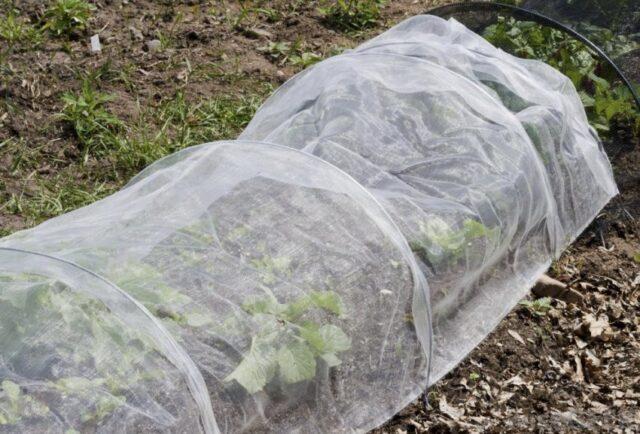
In most regions of Russia, Mara de Bois strawberries are allowed to be grown only under cover.
Disease and pest resistance
The variety is immune to powdery mildew. But resistance to other diseases is moderate or weak:
- fusarium wilting (brown bloom on the leaves, drying out);
- white spot (spots on the leaves);
- gray rot (mold on berries against a background of high humidity).
Also, the yield may fall due to the appearance of pests: slugs, aphids, weevils.
The main preventive measure is the treatment of Mara de Bois strawberries with Bordeaux liquid or other fungicides (before flowering):
- "Profit";
- "Ordan";
- Fitosporin;
- "Maksim".
Insecticides are used against insects:
- Fitoverm;
- Akarin;
- Biotlin;
- "Match".
It is also recommended to use folk remedies (infusion of tobacco dust, ash with laundry soap, garlic cloves, onion peels, decoction of potato tops and many others). The processing of Mara de Bois strawberries is carried out in cloudy weather or in the late evening, in the absence of strong wind and rain. If you use chemicals, then you can start harvesting only after 3-5 days or more.
All other plants must be immediately treated with a fungicide - folk remedies are not suitable in this situation.
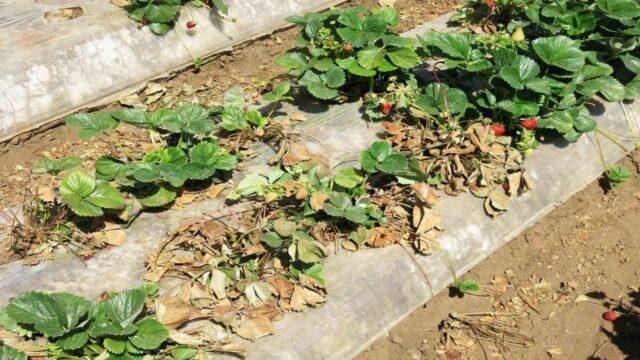
Fusarium is an incurable disease of strawberries
Advantages and disadvantages of the variety
The indisputable advantage of the Mara de Bois variety is a harmonious, sweet, bright taste with a pleasant strawberry aroma. This is a classic strawberry, the berries of which are especially pleasant to eat fresh. Along with this, they can be harvested in other traditional ways: jam, jam, berry juice.
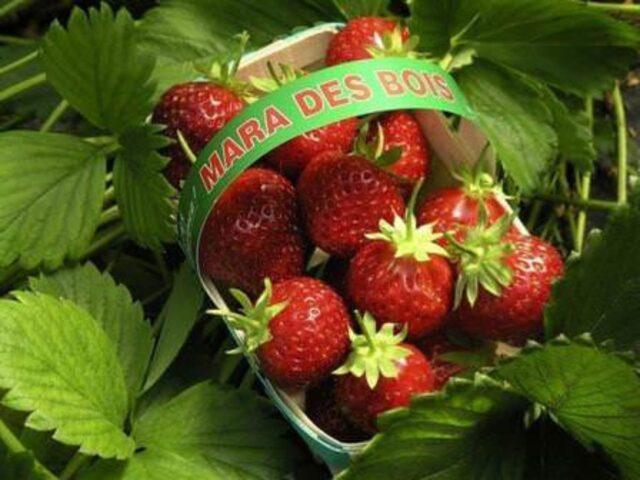
The Mara de Bois variety needs good care, but it gives very tasty berries.
Pros:
- exceptionally pleasant taste;
- delicate, juicy consistency;
- presentation berries;
- high productivity;
- the bushes are compact, do not take up much space;
- yields a harvest from June to September;
- immunity to powdery mildew;
- can be grown not only horizontally but also vertically.
Minuses:
- culture is demanding to care for;
- average frost resistance;
- drought does not tolerate;
- there is a tendency to a number of diseases;
- there are voids in the berries;
- gives a lot of shoots that need to be removed.
Reproduction methods
Mara de Bois strawberries are propagated in standard ways:
- mustache;
- dividing the bush.
The plant has a lot of shoots. As they appear, they are cut off from the mother plant and planted in moist, fertile soil, deepening 3-4 cm. This method is suitable for young plants of the first year of life.
Bushes that are 2-3 years old are recommended to be separated (in late spring or early autumn, after harvesting the entire crop). For this, the Mara de Bois strawberries are dug up and placed in a bowl with settled water. After a few hours, the roots will disperse on their own (no need to pull them). If a double horn is caught, it is allowed to cut it with a knife. Delenki are planted in a new place, watered, and carefully mulched on the eve of frost. In this case, all peduncles must be removed already at planting.
Planting and leaving
To grow large and tasty Mara de Bois strawberries, both in the photo and in the description of the variety, it is necessary to organize thorough care: the variety is demanding, but all efforts will pay off. First of all, you need to choose a place for Mara de Bois - the following requirements are imposed on it:
- moderately wet (not low);
- not arid (hillocks will also not work);
- the soil is light and fertile (light loam, sandy loam);
- the soil is acidic (pH in the range of 4.5–5.5).

Plantings can be covered with agrofibre
It is undesirable that Solanaceae, as well as cabbage, cucumbers, previously grew on the site where the Mara de Bois strawberry is planned to be cultivated. Best predecessors: beets, carrots, oats, garlic, legumes, dill, rye.
In the south, Mara de Bois strawberries are planted in late April or early May. In the middle lane - towards the end of May or early June in Siberia, in the Urals - in the first weeks of summer. It is recommended to preliminarily fertilize the soil (one month before) with manure - one bucket per 1 m2... Planting pattern: 25 cm between bushes and 40 cm between rows.
Rules for caring for strawberries Mara de Bois:
- watering weekly (in the heat - 2 times) with warm water;
- mulching with peat, sawdust, sand (layer at least 15 cm);
- mustache removal - regularly;
- loosening the soil - after wetting and heavy rains.
Mara de Bois strawberries are fed several times per season:
- In the spring, nitrogen compounds (urea or ammonium nitrate 15–20 g per 1 m2).
- During bud formation - wood ash (200 g per 1 m2), as well as superphosphates and potassium salt (foliar feeding).
- During the formation of fruits - organic matter (mullein or droppings): 0.5 liters of infusion per 1 bush.
Preparing for winter
To prepare the Mara de Bois strawberries for winter, you must remove all antennae and dry foliage and put spruce branches or agrofibre. If the winters are snowy, shelter is minimal.
Conclusion
The Mara de Bois strawberry is demanding to care for, but it is productive and gives very tasty berries, which differ significantly from a number of domestic varieties. It is better to grow under cover, in the south it is possible also in the open field. Regular watering, mustache removal and top dressing are required.
Reviews of the strawberry variety Mara de Bois
